|
|
|
|
| Low-Level Photography Reports See my book: Thunder Through the Valleys: Low Level Flying - Low Level Photography |
| Hellenic Air Force Low-Flying Training Hellenic Flying - Fast and Low! |
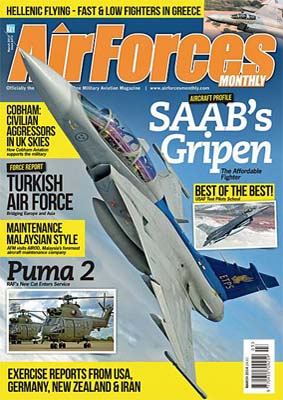
Greece's Hellenic Air Force (HAF) is totally committed to low-flying training, determined to be fully capable in making use of the terrain to evade enemy air defences. All HAF's fast jet squadrons train at low-level through their mountain ranges or over the Aegean Sea. "The terrain in Greece is very diverse and so ideal for low-level flying training with many high mountains and deep valleys as well as large areas of sea", explains Captain Eftichiadis Eftichios. He is an instructor pilot of the very potent Lockheed Martin F-16C/D Block 52+ Fighting Falcon with 337 MPK (Mira Pantos Kerou / All Weather Squadron), 110 PM (Pteriga Makhis / Combat Wing), based at Larissa. Rules, rules, rules Flying low is not without its dangers and is subject to many restrictions. HAF pilots are bound by rules designed to make low flying safe and avoid disturbing the population while enabling aircrew to maintain a high level of skill. Fast jet pilots are not allowed to fly lower than 300ft (91m) above ground level (AGL) and there are areas to be avoided, such as tourist beaches and archaeological sites. Over cities there is a 3,000ft (914m) AGL minimum. Areas with concentrations of birds must also be avoided either for part or all of the year. Capt Eftichios referred to a map of Greece with many red circular areas marked indicating all-year-round bird concentrations and green corridors showing seasonal bird migration flight paths. "Flying a single engine jet fighter the birds are a real threat. To avoid the bird migration routes we have to climb to 3,000 feet (914m) AGL which will take us above 95% of the birds, we have had cases of birds flying at 11,000 feet [3,350m]." The weather over the mainland and the sea presents more dangers to flying fast and low. And the humidity over the Aegean Sea can make it difficult to see the horizon. When flying low-level under cloud the cloud base must be no lower than 2,000 feet (610m). Capt Eftichios explained; "In the 1990s a number of aircraft were lost due to them being 'closed by the weather' because of low cloud which did not give the pilot a way out and they failed to execute the correct procedures." Areas for low-flying have been defined for the pilots to train without the risk of conflicting with other non-participating aircraft known as Very Low Flight (VLF) areas. VLFs are designated over land and sea, with them civilian flights are excluded and military pilots can perform low-level interceptions and evasion manoeuvres subject to less restrictive rules of engagement. The VLF upper limit is negotiated daily between military radar and civil aviation authorities and is generally between 5,000 feet (1,524m) to 8,000 feet (2,438m). The VLFs can also be utilised for night flying but will then have a lower limit of 1,000 feet (305m) when pilots are using night-vision goggles (NVG) and 2,000 feet (610m) if flying without NVGs. |
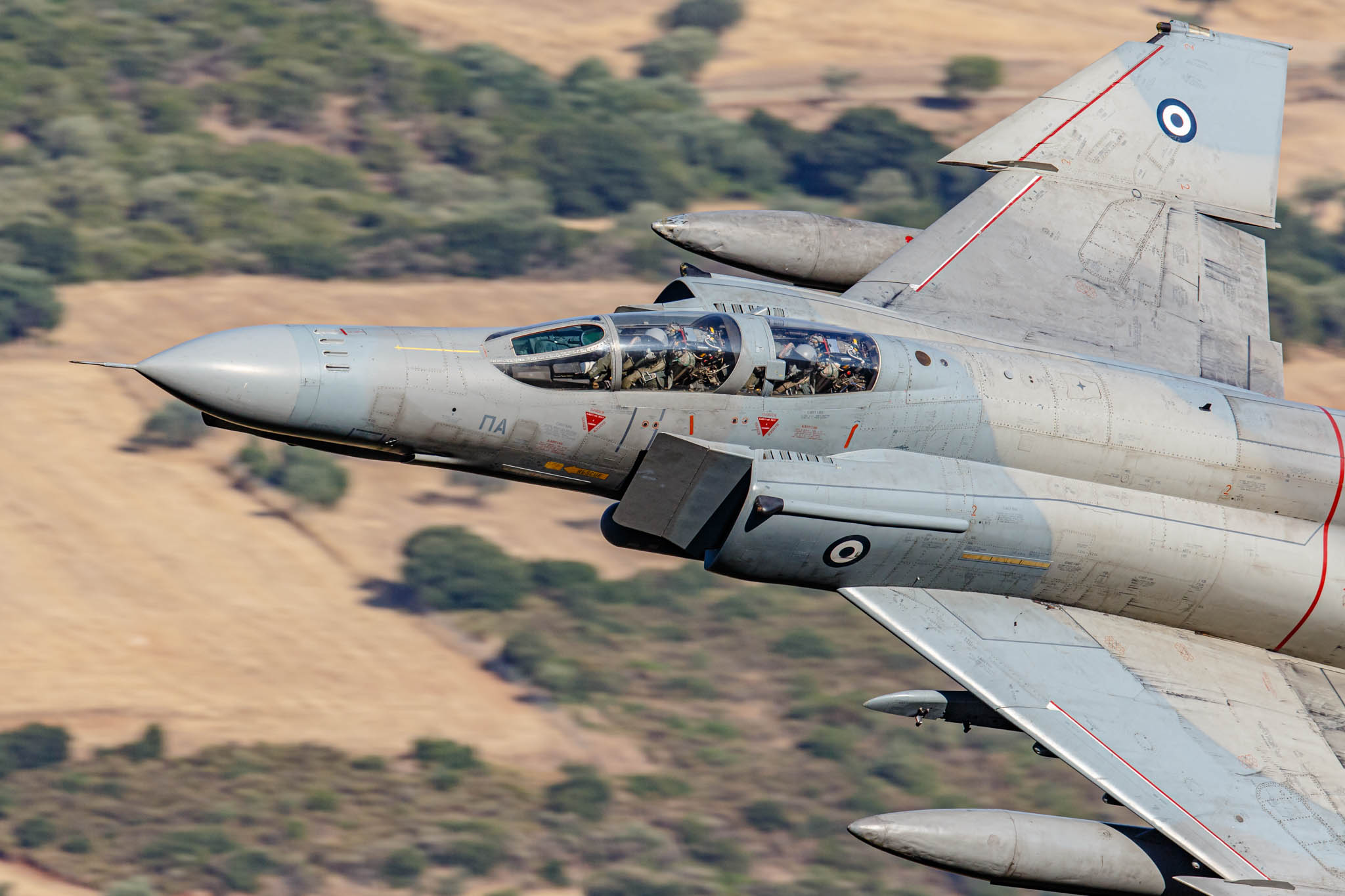 |
| 338 Mira F-4E(AUP) Phantom II (01524). The HAF ordered 56 F-4E Phantom IIs in 1971 and by 1978 all had been delivered. In 1997 36 of these were selected for the 'Peace Icarus 2000' avionics upgrade program (AUP) which included; the Raytheon Hughes AN/APG-65 radar, new colour multi-functional cockpit screens, new Heads Up Display (HUD) and a new Hands On Throttle and Stick (HOTAS) system, AMRAAM and AIM-9M capability and a Hazeltine AN/APX-113 IFF advanced friend/foe identification system (AFIDS). |
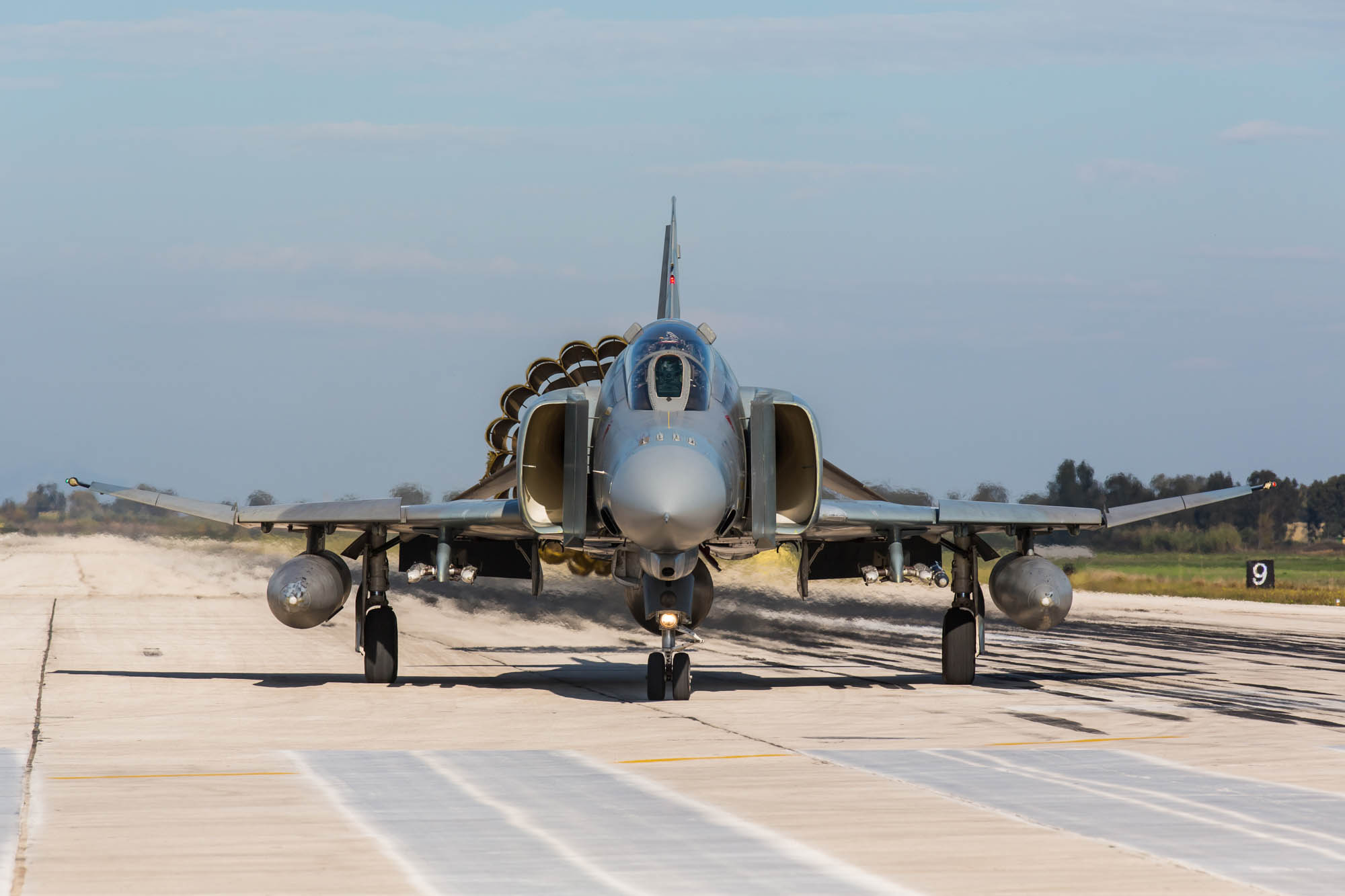 |
| F-4E(AUP) Phantom II (71743). With three underslung fuel tanks the F-4E(AUP) Phantom II can easily reach Cyprus without in-flight refuelling which was not possible for previous HAF fighters. |
Lt Col Avraam Kazantzoglou is the 338 MDV's (Mira Dioxis Vomvardamou / fighter-bomber squadron) commander with 117 Combat Wing at Andravida. He has 2,000 plus hours flying the F-4E(AUP) Phantom II says they are not restricted to using the pre-planned CPMs
Three or four ship formations cover the majority of training flights from Andravida it is not unusual to have six or eight ship formations. Lt Col Kazantzoglou; "We can fly mixed formation flights using F-16s from Araxos or other air bases in the force protection role to benefit all." 338 MDV's primary role is strike and so most of their flights are at low-level. Lt Col Kazantzoglou explained that the mission planned depends on the primary objective; "If it is just to assess the pilot's low-flying skills, then it will be low, low, low. We can simulate a flight that starts over friendly territory and is flown at medium or high level before descending at 40 to 50 nautical miles [74 to 93km] out to 500 feet [152m] or 300 feet [91m] AGL as we approach the target depending on the terrain and the electricity network." Electricity cables and wind farms add further obstacles to low-flying safety. "Low altitude ingress has to be realistic it can be perhaps 100 nautical miles [185km] out. As you approach the target and no closer than 50 nautical miles [93km] the WSO [weapons systems officer] will prepare the weapons systems, we check the navigational system to make sure it is properly aligned and do the final checks to get the tactical go for the targeting pod." Before reaching the target they will typically fly at 420 knots or seven miles per minute, increasing to 480 knots for the basic ingress to target. "We can go to 540 knots which is nine miles per minute, these speeds are just for planning purposes during the mission we will adjust the speed to make sure we keep to our TOT [time on target]. |
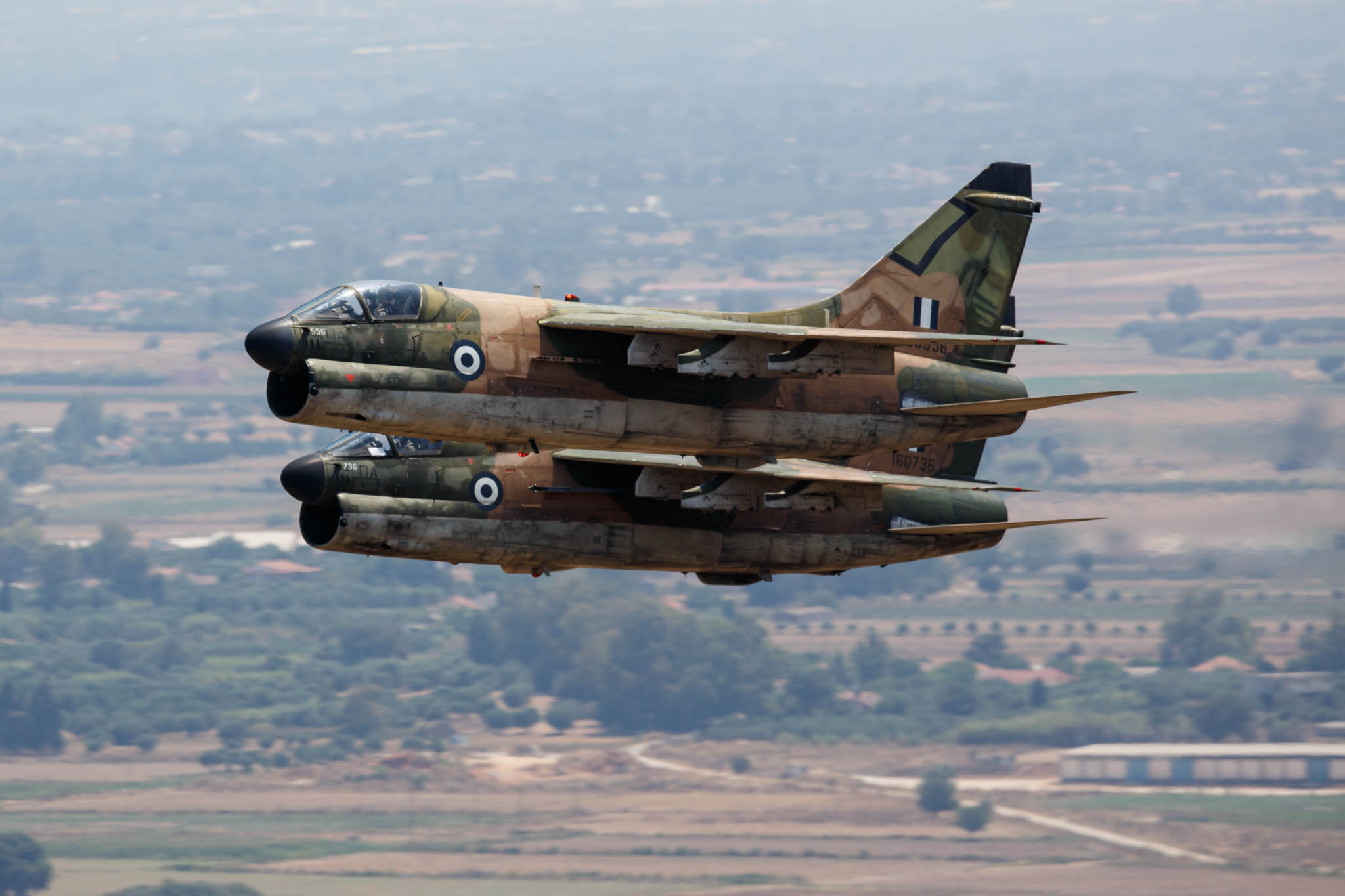 |
| A-7E Corsair II pair (160556 and 160736) with 336 MV (Mira Vomvardamou / Bomber Squadron) assigned to 116 Combat Wing at Araxos. The Corsair II which first entered service with the HAF in 1975. The A-7 is expected to be retired later this year.After 1986 the A-7Es were equipped to carry the AAR-45 LANA (Low-Altitude Night Attack) FLIR (Forward Looking infrared) pod (see inner starboard pylon) which projects an amplified light image on the Head-Up Display (HUD) and in conjunction with Radar, it enables terrain following down 200 feet (60m) at to 460 mph (740 km/h). Smart weapons in conjunction FLIR can be delivered day and night. |
Captain Nikolaos Koutridis is an instructor pilot flying the McDonnell Douglas RF-4E Phantom II with 348 MTA (Mira Taktitis Anagnorisis / Tactical Reconnaissance Squadron) at Larissa. He described their mission to photograph enemy targets at low-level; "The American's use the phrase; 'first in last out', you have to go in first to identify and designate the target and then return to photograph the damage incurred from the attack." He added; "Our role is to reach the target area survive enemy air defences which is why we fly at low-level."
The captain described a typical mission; "From five miles out and flying as two pairs we will maintain visual contact with each other. Near to the target we 'pop-up' to a higher height according to the required aspect of the camera and resolution of the image and what our commanders want to see. The first pair could fly over the target followed soon after by another pair flying from the side to compress the air defences. We would then link up again to before the RTB [return to base]." The pilot flies aggressively as is necessary when approaching the target and for the 'pop-up' but then will fly smoothly for the backseat who takes the photographs. The pilot will then step down his height and use jink out manoeuvres to egress from the target area using pre-planned points. Careful planning is essential for these low-level reconnaissance missions; "It's then a compromise between protecting yourself from the air defence and taking the photographs", said Capt Koutridis. "You plan the mission deciding heights and distances from the target and the direction to approach it. You then work backwards to decide where you 'pop-up', where you increase the power and right back to departing the air base." The debrief F-16 Instructor Pilot Capt Eftichios was emphatic when discussing the reasons for a debrief at the end of a mission; "A mission without a debriefing is a mission that did not happen, the actual training is during the debrief." There is no time to train during the flight, procedural errors, such as not calling a ground controller or tactical mistakes, such as not reacting interceptors efficiently can only be dealt with when back at base. Capt Eftichios explained; "The debrief starts with an overview of the mission and then follows some standard steps. When we get to the mission reconstruction the pilots discuss the key points, everyone presents their point of view only then do we look at the cockpit video, because this does not lie." Crew resource management (CRM) is discussed by the two-seat crews to make sure they are working together as effectively as possible. What was good what was bad and how improvements can be implemented. For example; "You discuss the errors, such as the 'pop-up' was too smooth and should be more aggressive or the speed was too slow over the target." Were all elements that were briefed achieved, were the primary objectives plus other objectives such as mutual support, all met?" |
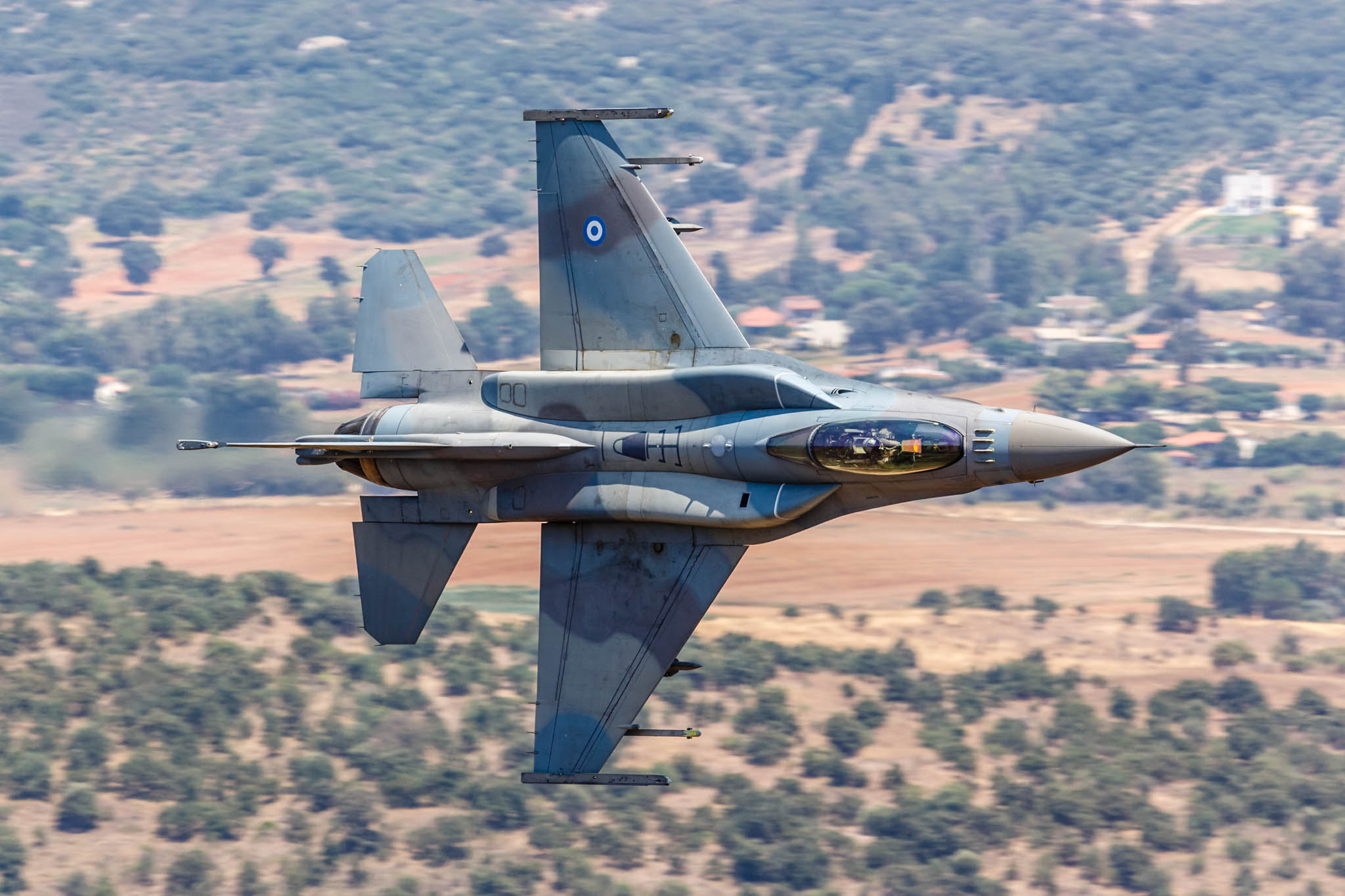 |
| Conformal Fuel Tanks (CFT) fitted to this F-16C Block 52M Fighting Falcon (020) are reported to have little effect on the F-16’s performance with regard to agility and handling, pilots can still pull 9g. They are very fuel efficient when compared with conventional tanks carried under the wings and the aircraft's radar signature is also little affected. Captain Eftihidis Eftihios an F-16 Block 52+ pilot said, "CFTs are good for long range missions with excellent performance for air-to-ground missions. I would use them for combat air patrol (CAP) but not in a close dogfight as they can't be jettisoned." |
| Low-flying techniques Low-level flying is a skill not easily learned or retained it requires regular practice using proven techniques that evolved over time. Capt Eftichios described the cockpit routine when flying fast and low; "You should focus on the near rocks then the far rocks (to plan ahead) then check six for your mate (mutual support) then check the instruments and HUD [Head-Up Display]. It is a circular motion around the cockpit." To add to its challenge it is common where the terrain is plain to lose focus of the horizon more usually when flying over the sea. The golden rule at low-level is to fly as fast as possible because if anything happens the pilot can maximise his altitude quickly. Capt Eftichios said; "Pilots tend to push the throttle further to fly quicker because it makes them feel safer, the aircraft is more responsive the faster you go. The Grandmother's theory is to fly low and slow but this is not safer! We are flying a single engine if it fails the time we have is proportionate to its airspeed", warning; "At 200 knots you don't have an aeroplane." When pilots reach their first squadron for conversion training they are fully taught on low-level terrain masking as opposed to terrain follow techniques. When terrain following an aircraft will pass over a rise in the terrain in level flight and will incur negative 'g'. When terrain masking the pilot flies his aircraft almost inverted with positive 'g' over a ridge, this minimises by three or four times the period the jet is 'sky-lined' above a ridge line. The aim is to minimise the time the aircraft is above the peaks and so reduce the chance of being detected by the scan of an enemy Radar both from the ground and from the air. Pilots in pursuit of a low-flying aircraft which is employing terrain masking techniques are often unable to use their air to air missiles. The background will affect systems reducing a missiles effect envelope infrared heat-seeking missiles can be confused by the humidity. |
The Air Tactics Centre (Kentro Aeroporikis Taktikis, KEAT) is an independent wing of the HAF established in 1983. Its mission is to provide advanced education via the Tactical Weapons School (Scholio Oplon Taktikis, SOT). It also coordinates between Air Force, Army and Navy for the testing and evaluation of new equipment and weapons prior to them being issued to the squadrons. Normally once a year but sometimes twice, the SOT receives the best pilots from across all the squadrons to attend its courses on air-to-air and air-to-ground tactics including composite air operations (COMAO) packages and electronic warfare. Lt Col George Bontzios is SOT Commander; "The mission of the SOT is to provide the best training for our best professionals not just pilots, so they can become elite."
Each SOT fighter aircraft course is held at Andravida and lasts up to four months the first part is theoretical leading to the flying course which lasts around ten weeks with pilots flying up to 20 sorties. Months of planning go in to each course, it is carefully structured to use the knowledge of air warfare developed over many years and the experience of aircrews. Graduates of the SOT course return to their squadron as instructors. "The training here is more realistic with more and varied assets which are used by experts. In the SOT you will fly four versus four or four versus eight. We have aircraft of every type and GBADs [Ground Based Air Defence] from Stinger to Patriot [ground to air missiles], it is very challenging for them", explained Lt Col Bontzios. Low-level flying tactics are employed throughout the exercise, Lt Col Bontzios spoke of the need for low-flying; "If you fly high you can be seen by everyone 5,000 feet [1,524m] up to 25,000 feet [7,620m] is a dead man zone", adding; "There is no perfect weapon at low-level." A COMAO is a package of aircraft with different roles, at the SOT it can consist of 16 to 20 aircraft and is typically put together to mount an attack on another squadron or wing. The SOT course builds up to a two week period where COMAOs are used to prepare the pilots to become mission commanders. Lt Col Bontzios described the previous days COMAO where 16 SOT aircraft named 'blue air' were pitched against six Tanágra (114 Combat wing) based Dassault Mirage 2000-5s named 'red air'. 'Blue air' was tasked to attack several ground based targets and low-level flying played a major part in the game plan. "It was a complex scenario fought over a large area with RV [rendezvous] points." The SOT can reserve airspace as large as 80 by 100 miles [129 to 161km] with 'unlimited' altitudes (up to 50,000 feet [15,240m]) for their exercises. "They had to pass 'red air' over the sea and descend over the ground to fly at low-level to attack targets defended by 'red air', finally they bombed Andravida at the end of the mission." Force protection was flown by F-16C Block 30s with F-16C/D Block 52+s and F-4Es. A pair of Ling-Temco-Vought (LTV) A-7E Corsair IIs were used as bombers along with more F-4Es armed with Laser Guided Bombs and advanced F-16C/D Block 52Ms with a full range of weapons. A single reconnaissance RF-4E was utilised for Battle Damage Assessment (BDA) protected by an F-16D Block 52+ equipped with AIM9C Sidewinder heat-seeking missiles, Advanced Medium-Range Air-to-Air Missiles (AMRAAM version C7) and the IRIS-T air to air missile. The COMAO debriefing will last for many hours, it is held on the following day and will start at 0700 hrs and can last until 1900 hrs. |
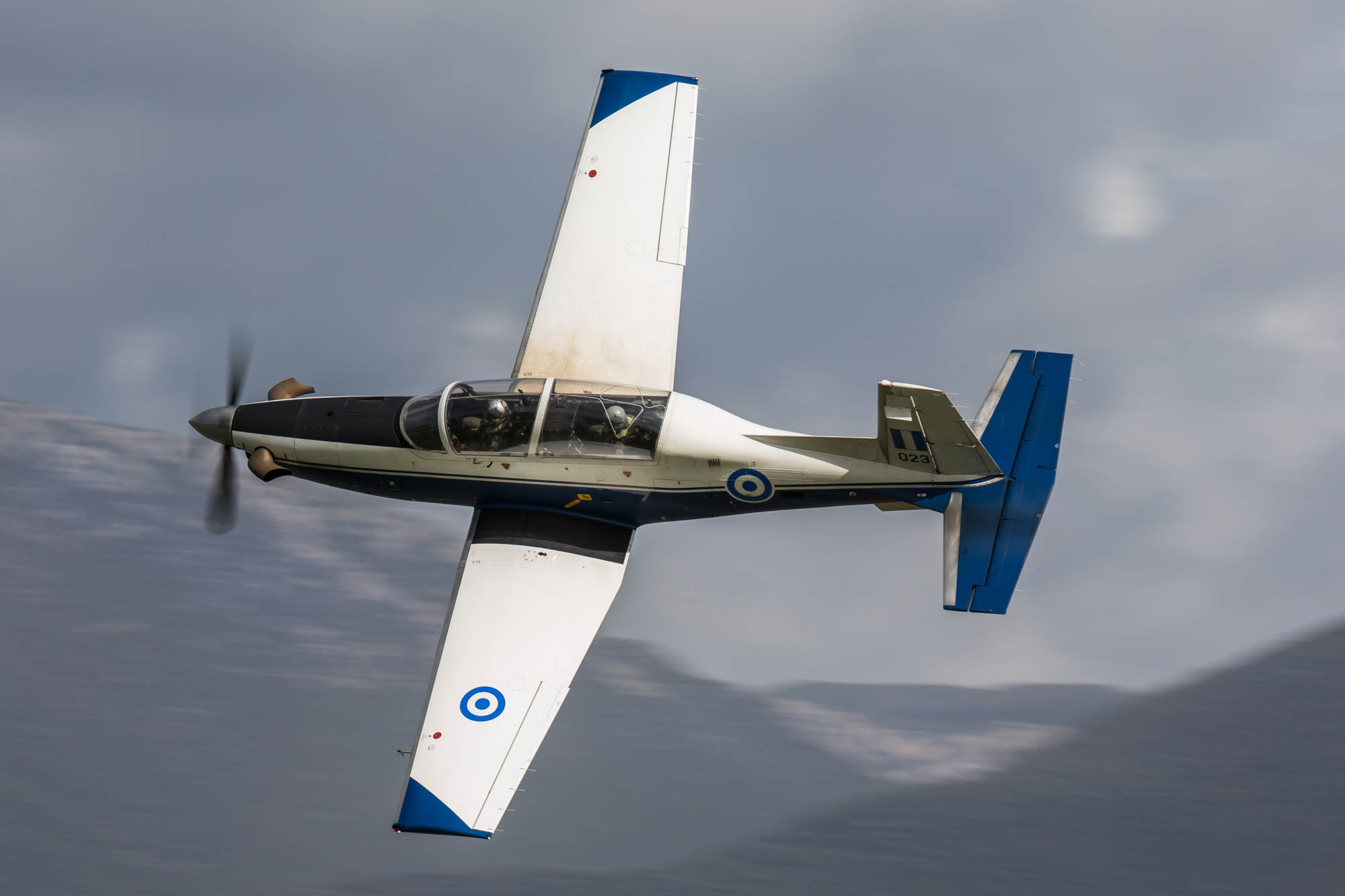 |
| T-6A Texan II (023). The T-6A Texan II is operated by 361 and 364 Air Training Squadrons at Kalamata for basic flying training. Students progress to flying low-level navigational training down to the mountain tops but no lower than 1,000 feet (305m) AGL. |
Pilots joining the HAF commence Phase I of their basic flight training at the Flight Academy at Tatoi-Dekelia air base and fly around 35 hours on the Cessna T-41D Mescalero. This is a screening programme that does not include any specialised low flying, just medium-level navigation. The best students are selected for the basic training course at 120 Pteriga Ekpetheusis Aeros (PEA / Air Training Wing), Kalamata. In phase two, student pilots initially fly the Raytheon T-6A Texan II with either 361 or 364 Mira Ekpetheusis Aeros (MEA / Air Training Squadron), which run identical basic flying training courses in parallel. Successful students move across to phase three, with either 362 or 363 MEA, to fly the North American T-2E Buckeye, again based at Kalamata, for the advanced flying training course. The Texan II course it starts with ground school using the Computerised Basic Training Systems (CBTS) which is includes a flight simulator. Next comes the 'contact phase' with a flight instructor and a succession of sorties featuring; landing patterns, emergency procedures, stalls, aerobatics, loops and Immelmann manoeuvres. Later instrument based sorties are flown with instrument landing system (ILS) approaches to other airfields. Each phase ends with an evaluation.
Lt Col Nikolaos Tsivourakis the 361 MEA's commander, pointed out that even at this early stage in a pilot's career the student is being prepared for low-level flying; "The whole course prepares a pilot for flying at low-level. It includes situational awareness, avoiding mountains, avoiding the weather and reacting to emergency situations such as bird strikes." The T-6A Texan II course totals 100 sorties and lasts for one year. With the transfer to either 362 ATS or 363 ATS and the start of Phase III, it is the student pilot's first opportunity to fly a jet aircraft. After ground training lectures and 18 sorties on the flight simulator the student will fly ten sorties with an instructor followed by his first T-2E Buckeye solo flight. A further ten sorties, three of which are solo with more advanced manoeuvres, a night flight and final check ride now follow. The next element of the course consists of 23 flight hours and introduces the student to formation flying and basic fighter manoeuvres (BFM) it concludes with check ride. Navigation training is next, starting with two sorties at medium level followed by nine 500 feet (152m) trips flown initially as a single ship followed by two, three or four ship formations. All these sorties are with an instructor and finish with a check ride to conclude the phase of over twelve hours of flying, most of which were at 500 feet (152m) at 300 knots. Phase IV of the course introduces air-to-ground firing exercises, starting with simulated attacks before live weapons are used on nearby ranges. Students use the CPM low-level flight plans for the first time half way through this 24 sortie phase which again finishes with check ride. After a total of 80 flight hours and 71 sorties in the T-2E Buckeye, eight of which were solo, the student should be able to progress to his first frontline squadron for conversion training. Students are asked for their first choice of squadron taking into account whether they excelled in the air-to-ground or air to air scenario. Major Vasilios Asimakopoulos 362 ATS Commander explained that although pilot's wishes are considered these are not always met; "The best students are retained here as instructors which may not be their first choice, the needs of the air force come first." Some students will move to helicopters or transport aircraft. |
Graduates of the Air Training Wing transfer to an Operational Conversion Unit (OCU) to learn to fly their selected frontline aircraft. When comfortable with the faster speeds the young pilots will step down to 500 feet (152m) in stages. It is not till they reach their final squadron do they make the final step down to 300 feet (91m) first over the sea and then over land and includes the introduction of terrain masking techniques. This is typically achieved over three or four flights in a two-seat F-16D, TA-7C or F-4E depending on the young pilot's new squadron. Once down to 300 feet (91m) then ground and air to air threat reactions are introduced during a further three flights. Lt Col Kazantzoglou explained a learning curve as the young pilot's experience increases; "When you are inexperienced a small amount of effort gives you a much bigger boost in performance but as you gain experience the opposite becomes true." Continuing he said; "When you first become a pilot you are focussed on what is in front of you and maybe ten degrees to the left and right. The more experienced you become the wider the view until you start to be aware on what is going on behind your back five or 20 miles [32km]." Lt Col Bontzios an SOT and TLP graduate with 1,000 plus hours on the F-16 Fighting Falcon knows how challenging it is to fly at low-level; "You need a good knowledge of your own capabilities, the aircraft's limits and capabilities and the environment. Low-level flying is very demanding if you underestimate something you are dead in a few seconds." He described the mathematics of a fast jet flying at low-level employing terrain masking; "If you fly low-level and turn with a 60 degree bank angle you need about 2g to maintain level flight but if you make a bank angle of 85 degrees you need 11g. For terrain masking you usually only go to 4g or 5g, but if you have to go to weapons engagement or weapons denial then we will go to the aircraft's limits of 7, 8 or even 9g." If a pilot does not fly a defined profile, such as low-level for a set period of days then the pilot is said to be out of practice or to have lost his currency. Capt Eftichios explained flying currencies; "For younger pilots they are perhaps 60 days with 120 days for more experienced pilots. If you have not flown an exercise such as a low-level mission for more than the currency figure then you cannot fly alone, you need to fly a two-seater with an instructor pilot to regain qualification." Squadrons have a special team responsible for flying check rides with pilots that have lost their currency. "This is one of the most difficult jobs in peace time training as they have to stay current in all activities." 337 MPK have 24 F-16C/D Block 52+ pilots assigned eight of whom maintain all the currencies to fly check rides, the exercises and the currency days are defined by HTAF. |
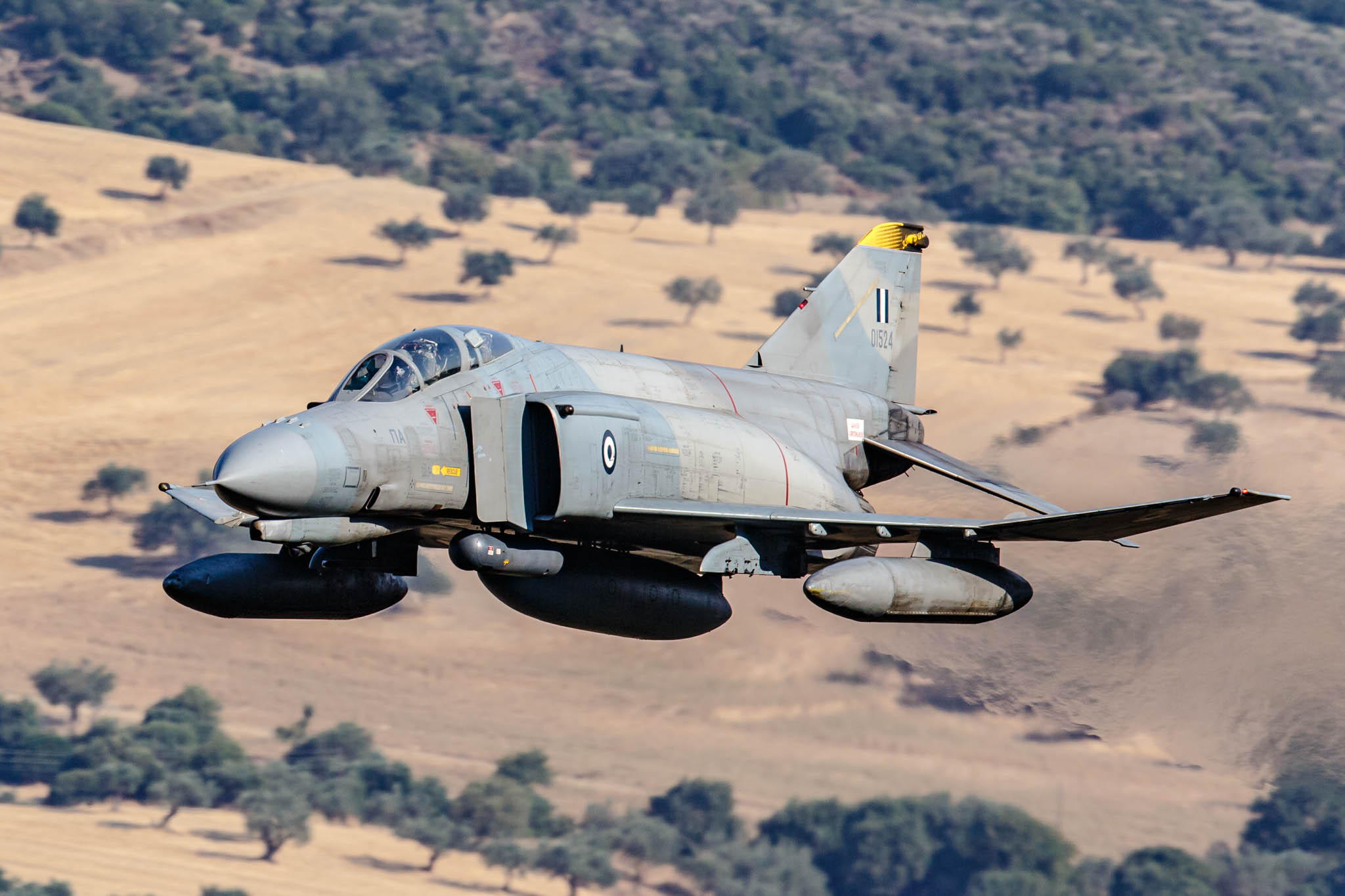 |
| 338 MDV F-4E(AUP) Phantom II (01524). The F-4E(AUP) Phantom IIs are all based at Andravida with 117 Combat Wing which is divided in to two Squadrons, 339 'Aias' All weather Interception Squadron and 338 'Ares' Pursuit Attack Squadron distinguished by their yellow fin tips. |
The proportion of a pilot's low-flying hours flown in each type varies with the mission of each squadron. At Araxos air base 336 MV (Mira Vomvardamou / bomber squadron) assigned to 116 Combat Wing flies the A-7E Corsair in the air-to-ground strike role, the Squadron Commander Lt Col Petez Mittaris, reported that 83% of his squadron's flights were at low-level. However also based at Araxos is 335 Fighter Squadron flying the advanced multi-role F-16C/D Block 52M Fighting Falcons primarily in the air-to-ground strike role report that only 60% of their flights are at low-level. Pilots with 339 MPK flying the F-4E Phantom II in the air defence role naturally conduct fewer low-level flights of between 20% and 30% total to retain their skills for air-to-ground strikes. The 337 MPK flying the F-16C/D Block 52+ Fighting Falcons have a primary role of combat air patrol and force protection they report that only 20% of their flying training is at low-level for when they are tasked to escort fighters at low-level. Greek skill There is a consensus of commanders and instructors interviewed that the A-7 Corsair pilots are the best low-flyers in the HAF. It was acknowledged that the F-16C/D Fighting Falcon was very capable at all levels from high right down to low-level, but pilots due to the aircraft's multi-role mission spend much less time hugging the terrain, where as the A-7 Corsair pilots spend the vast majority of their flying time at low-level and so were more experienced. A former A-7 Corsair and F-16 Fighting Falcon pilot Maj Asimakopoulos says his favourite aircraft to fly at low-level is the A-7 Corsair as it is very stable and you can really 'feel' the aircraft; "It's a pilot's aircraft." He went on to say that he had learned that; "The ground can be your best friend and your worst enemy", it's clear that all HAF fast jet pilots are on very friendly terms with the terrain. |
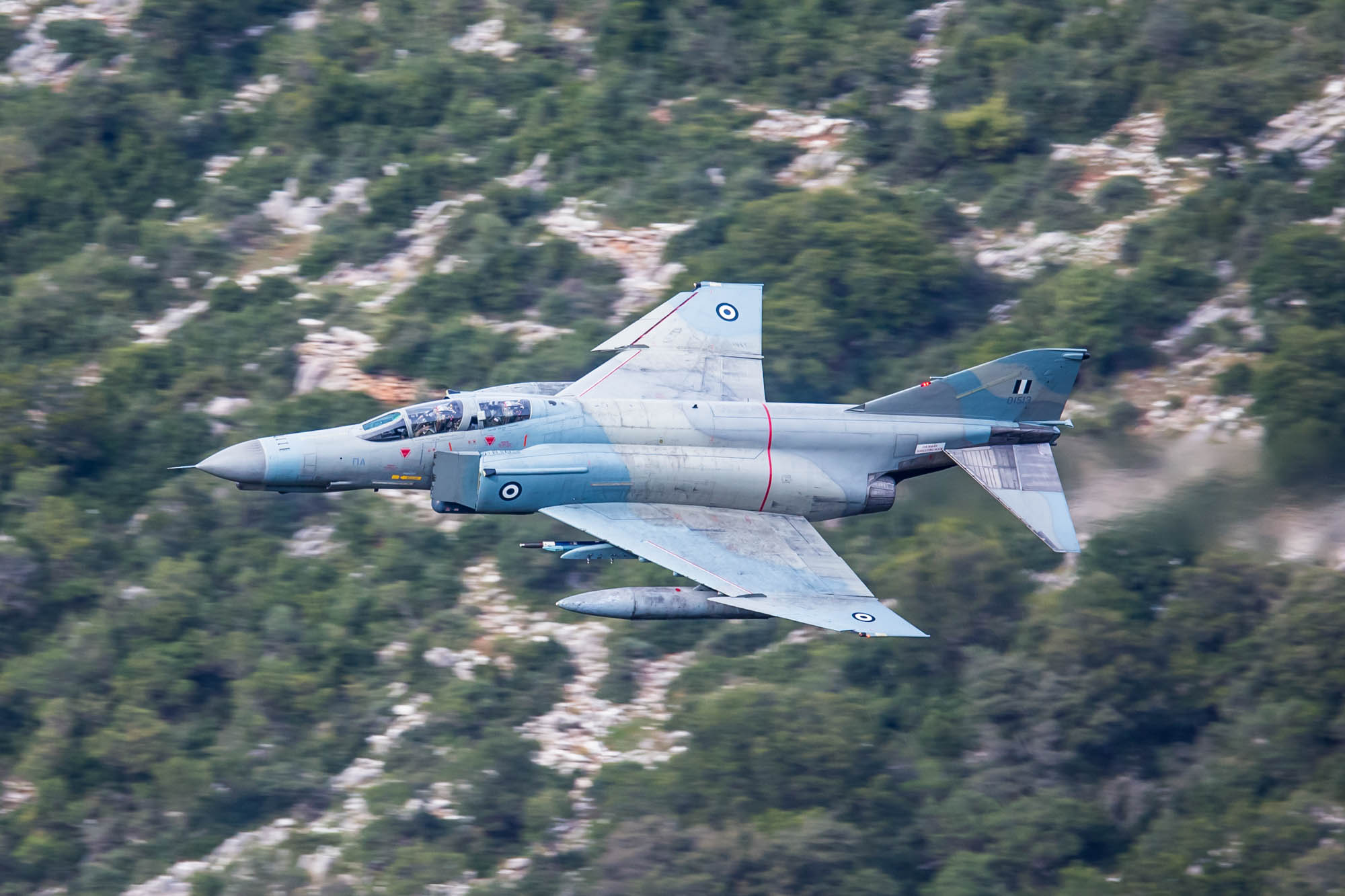 |
| 339 MPK F-4E(AUP) Phantom II (01513), the avionics upgrade program (AUP) was completed in 2004 and enabled the addition of the Rafael Litening II sensor pod (mounted under forward fuselage) for navigation and targeting for close air support weapons such as precision-guided bombs and Raytheon AGM-65 Maverick missiles and the advanced IRIS-T air-to-air missile. |